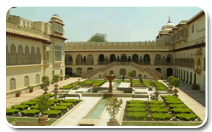RAM BAGH
Ram Bagh, a beautiful Mughal Pleasure Garden, is located 3 kilometers from the Tomb of Itmad-ud-Daulah and 500 meters from Chini-ka-Rauza.
The Mughal Emperors of India were very influenced by their Persian background. In Persia, the pleasure garden is an important part of the landscape of every city. The Mughal Emperors introduced the same concept in India. In Islam, the garden is considered a representation of Paradise, a word derived from paridesa, which means land of fairies. Devout Muslims should not only aspire to reach paradise but should strive to create its likeness on earth. Therefore the Mughal Emperors laid out many beautiful gardens to create a paradise within their kingdoms.
Babur, the founder of the Mughal Empire, created this garden, which is also known as Bagh-i-Gul Afshan. Noorjahan, the wife of Jahangir, the fourth Mughal Emperor, made further additions to Ram Bagh.
The garden is laid out in the Char Bagh pattern, with four main divisions made by paths and waterways. Water is an important part of Mughal gardens, since water is considered the source of life. Water from River Yamuna flows, over three terraces in a series of cascades. Stairs on either side of the water channels, fountains, an island platform and two pavilions on either side of the main water channel, are added attractions of Ram Bagh.
It is believed that Babur was buried briefly in Ram Bagh before being entombed in his grand mausoleum at Kabul in Afghanistan.



